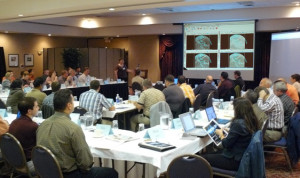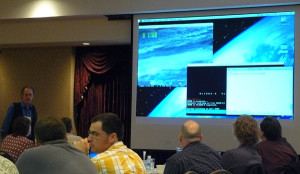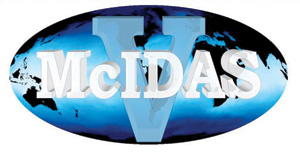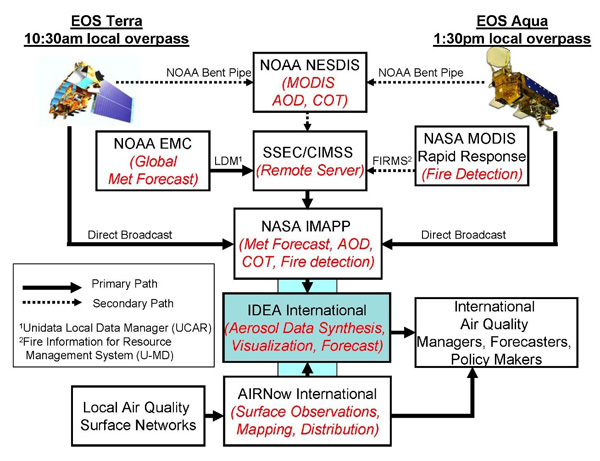Monthly News Summary – June 2009
- McIDAS Users’ Group Meeting Focuses on McIDAS-V
- AMS 10th Conference on Polar Meteorology and Oceanography Held in Madison
- Air France Disaster and Rapidly Developing Storms Highlighted on CIMSS Blog
- U.S. Group on Earth Observations Health Task Team Teleconference
- Publications
McIDAS Users’ Group Meeting Focuses on McIDAS-V
Over 60 scientists and researchers attended the McIDAS (Man computer Interactive Data Access System) Users’ Group (MUG) meeting held in Madison, Wisconsin, on 2-4 June 2009. McIDAS, SSEC’s flagship visualization and data analysis software package, is used by numerous university, government and commercial groups for weather data analysis and display. A demonstration of the fifth generation McIDAS, referred to as McIDAS-V, now in beta release, was followed by a day and a half of hands-on McIDAS-V training.
On Tuesday, presentations by the McIDAS User Services staff provided updates on the current developments in the McIDAS software packages. SSEC and CIMSS scientists gave demonstrations on how they’re using McIDAS-V in their current research projects. NESDIS and EUMETSAT representatives updated the attendees on the current and future environmental satellite systems for the U.S and Europe. The after-hours “Working Reception” on Tuesday evening mixed experienced users with beginners in a round table of demonstrations and exploration.
Wednesday morning saw presentations highlighting GOES-R and preparations for future satellite capabilities. Wednesday afternoon and Thursday were devoted to training on the new McIDAS-V software.
For more information, visit the McIDAS-V Web site.
submitted by Becky Schaffer and Mark Hobson
AMS 10th Conference on Polar Meteorology and Oceanography Held in Madison
The American Meteorological Society (AMS) held its 10th Conference on Polar Meteorology and Oceanography in Madison, Wisconsin, 18 – 21 May 2009. Scientists from the NESDIS/STAR Advanced Satellite Products Branch (ASPB), the Cooperative Institute for Meteorological Satellite Studies (CIMSS), and the Space Science and Engineering Center (SSEC) gave oral and poster presentations.
Robert Aune, with co-authors Scott Lindstrom and Kathy Strabala, gave a presentation on a project to develop a portable, real-time numerical weather prediction system that assimilates information from the Moderate Resolution Infrared Spectroradiometer (MODIS). The system, called Direct Broadcast CIMSS Regional Assimilation System (DBCRAS), runs at any local direct broadcast ground station in the world where MODIS data is received and processed.
Yinghui Liu (CIMSS), with co-authors X. Wang and J. Key, presented a method to remove the effects of trends in Arctic cloud cover and sea ice extent on the surface temperature trend. X. Wang (CIMSS), with co-authors Y. Liu and J. Key, demonstrated a new method of estimating sea ice thickness from optical satellite data.
Other presenters included Matthew Lazzara with four presentations and a poster and Shelley Knuth. The three student volunteers from SSEC were DJ Rasmussen, Nicole Schroeder, and Lee Welhouse.
Air France Disaster and Rapidly Developing Storms Highlighted on CIMSS Blog
Meteosat-9 IR images of the storm systems in the area where Air France Flight #447 disappeared.
Did weather play a role in the tragedy of Air France Flight #447? Click here for an analysis of weather conditions that faced the ill-fated aircraft.
U.S. Group on Earth Observations Health Task Team Teleconference
Brad Pierce participated in U.S. Group on Earth Observations (USGEO) International Working Group (IWG) Health Task Team teleconference on 21 May 2009 to summarize the potential implementation of Infusing satellite Data into Environmental air quality Applications-International (IDEA-I) into the International Moderate Resolution Imaging Spectroradiometer/Atmospheric Infrared Sounder (MODIS/AIRS) Processing Package (IMAPP).
The objective of IDEA-I is to develop an open source, portable aerosol forecasting and visualization tool for release to the international Air Quality community to provide interoperability between satellite observing systems and international surface air quality networks within AIRNow International. AIRNow International is being developed by the U.S. Environmental Protection Agency (EPA) under the auspices of USGEO.
Schematic illustration of how IDEA-I will be used to link MODIS satellite data and trajectory forecasting capabilities to AIRNow-I.
Manuscript on GOES Soundings in Cloudy Conditions Published: A manuscript entitled “Forecasting and nowcasting improvement in cloudy regions with high temporal GOES sounder infrared radiance measurements” has been published in the Journal of Geophysical Research (2009, J. Geophys. Res., 114). Coauthors are Zhenglong Li, Jun Li, Paul Menzel, J. P. Nelson (CIMSS), Tim Schmit (STAR), Elisabeth Weisz and Steve Ackerman (CIMSS).
Article Published on the Use of Satellite Measurements to Quantify Background Ozone Production: A manuscript entitled “Impacts of background ozone production on Houston and Dallas, Texas, air quality during the Second Texas Air Quality Study field mission”, has been published in the Journal of Geophysical Research (2009, J. Geophys. Res., 114). This study demonstrates how global chemical data assimilation systems, combined with Lagrangian trajectory techniques, can be used to quantify the impacts of background ozone production on the Houston and Dallas metropolitan areas. Coauthors are R. Bradley Pierce (NOAA/NESDIS), Jassim Al-Saadi (NASA/LaRC), Chieko Kittaka (NASA/LaRC), Todd Schaack (UW/SSEC), Allen Lenzen (UW /SSEC), Kevin Bowman (NASA/JPL), Jim Szykman (US/EPA), Amber Soja (NASA/LaRC), Tom Ryerson, (NOAA/ESRL), Anne M. Thompson (PSU), Pawan Bhartia (NASA/GSFC), Gary A. Morris (Valparaiso University)
Article Published on Quantifying the effects of Clouds on Photolysis Frequencies: A manuscript entitled “Sensitivity of photolysis frequencies and key tropospheric oxidants in a global model to cloud vertical distributions and optical properties” has been published in the Journal of Geophysical Research (2009, J. Geophys. Res., 114). This study shows that direct radiative impact of clouds on global tropospheric chemistry is more sensitive to cloud vertical distribution than to the magnitude of the cloud optical depths. Coauthors are Liu, H., J. H. Crawford, D. B. Considine, S. Platnick, P. M. Norris, B. N. Duncan, R. B. Pierce, G. Chen, and R. M. Yantosca.





